-
Posts
13,716 -
Joined
-
Last visited
-
Days Won
167
Content Type
Profiles
Forums
Events
Store
Downloads
Gallery
Everything posted by Bruce Pennington
-
I like these "on request" blades. Good luck with the sale, Oliver!
-

Recently Purchased Collection of 3 Gunto
Bruce Pennington replied to Fusilier's topic in Translation Assistance
Thanks for the other swords, Dave! 1. You will need to post shots of the bare blade, full length, and a couple of close shots of mid-section and tip, so the nihonto guys can help with an age range. 2. The Ufifusa with Showa stamp - which one is it of the 3? -
You'll see your answer on that first link. But it's a fittings inspection sticker of the Seki Cutlery Manufacturers Association. Can you post a photo of the whole rig?
-

Real or fake gunto? Traditionally made?
Bruce Pennington replied to Ronald Aguirre's topic in Military Swords of Japan
It is legit. Civil sword refitted for the war. Others might be better at dating, but I'd start with early/mid '30s and could be traditionally made. -
The steel is known as Damascus steel and is well known in Chinese swords. The mei is not Japanese. The ito folds all turn in the same direction - standard Chinese. Japanese ito twist in alternating directions. It is a sword, but not Japanese.
-
Trivia note: While the arsenal stamped blades were almost totally tachi mei, the star-stamped blades were roughly 1/3 katana mei (like the Tsuguyoshi blades) and 2/3 tachi mei. No idea why.
-
I can see hamon on this photo, so not chrome. A simple buffer on a cordless drill will make a shine like this. I like it. Unique. Got personality.
-
I think I've posted this before on NMB, but can't find it, so posting here. Holes all around the tsuba of this Nagamitsu RS. Posted by Arisakadogs and Ekkodo on this Gunboards Thread.
-
Pav, Can you get a shot of the bare naked nakago? There could be a star a bit higher. These numbered blades (and I see "ク125") are likely series by the Army fulfilling a contracted amount of blades. With very few exceptions, we see these numbers only on blades of RJT smiths (talking Army not Navy). I have another August '43 from him, so it probably has a star! 1943, Aug Tsuguyoshi (RJT) – Gunma ク122, Star Lareon, NMB, T98
-

Swordsmith identity
Bruce Pennington replied to Habaxi's topic in General Nihonto Related Discussion
If he had valuable blades from big named smiths, he'd sure as heck tell you and ask a high price. Refusing to give smith names means he's got mumei or common smiths and then wants to jack up the prices. -
The blade is interesting, but what do you think about those fittings? The saya is steel, so WWII era? but the fittings aren't. More like Chinese stuff, unless there were civil or tourist fittings that looked like this?
-

Navy Mount 26 1/2" Takemori ?
Bruce Pennington replied to Dogditcher's topic in Military Swords of Japan
Nothing on him in Sesko's book. There were several WWII smiths using that "Take" that are pretty much unknown. -
The Gifu stamp is a bit of an unknown entity. I used to think it was something the Seki Cutlery folks used as the large Seki stamp tapered off, but I found it was on tachi mei blades, like all the arsenal stamps. The civil stamps are on katana mei blades. So, looking at the timeline, the Nagoya "NA" tapers off after '43 and is practically gone by '45 (only 1 blade found with one from '45). While the Gifu begins in '43 and runs stead through '45. So, I think the Nagaya Arsenal used both in '43 and '44 and went completely over to the Gifu in '45. Unfortunately, I didn't think to make that change in thought in the Mar '25 Stamps doc. But it's in the update for next year.
-

Attention Mantetsu Owners: A Survey
Bruce Pennington replied to Bruce Pennington's topic in Military Swords of Japan
Nice one, Conway! I bet it's heavy! As to it's place in the series, it's hard to say exactly. '39 was the year of overlap as they finished out the English lettering N-Z (we only have examples of N, O, V, and W) and began using IROHOA. All the Alpha/numerics for '39 were "Spring" and the IROHA started with Spring, so either they finished the Alpha/numberics before staring IROHA or they ran the two numbering system simultaneiously. 1939 -- -- -- -- -- N-423春 N-574春 N-597春 O-4春 -- V-18春 V-33春 W-23春 W-38春 W-82春 -- None春 I イ(イ) i い Ro ロ Ha ハ Alpha Numeric Missing Kanji 1939 I イ RO ロ HA ハ NI ニ HO ホ I 132-S I 169-S I 376-S I 466-S RO 69-S RO 75-S RO 233S RO 270S RO 381S RO 446S HA 24-A HA 35-A NI 53-A NI 57-A NI 190-A NI 375-A NI 422-A NI 539-A Ni 657-A NI 679-W Ni 733-A HO 113-W HO 122-W HO 123-W HO 125-W HO 168-W HO 171-W HO 213-W NoNmr-W -
-
Hi Nazar, Other than the light color ito, it looks legit to me, and even the ito looks properly wrapped, so maybe custom job? Would help a lot to see the nakago (tang).
-
Ah, yes! Marking above habaki? Do you mean this: With all the pitting, I think it's just more corrosion/pitting. If it was a horimono, the corrosion has destroyed it. But Horimono is usually quite deep, and I think plenty would survive enough to be visible.
-
Mark, What I see looks like WWII legit gunto. Can you post a pic of the nakago?
-
Thanks Mark. With the corrosion, it's hard to say for sure, but I think there is a Showa stamp. I have dated blades from him, on file, made in 1940, '41, and '42. Most Showa-stamped blades were made in 1940 - 1941.
-

Officer Type 98 with Type 95 Blade
Bruce Pennington replied to Bruce Pennington's topic in Military Swords of Japan
Good catch Trystan. I’ll have to correct my files. -
I'm the worst guy to ask, as I don't study that stuff. The pics are fuzzy when zoomed, but I think I see hada in the steel. I don't see the famous black spots in the hamon of an oil quench, but the artificial polish might have obscured that. Mostly, I don't think the focus of the photo is clear enough to say. But again, I'm really not the one to ask.
-
-

Officer Type 98 with Type 95 Blade
Bruce Pennington replied to Bruce Pennington's topic in Military Swords of Japan
This was in Plimton's book. No blade shown: This one leads into the group of gunto with varing amounts of mixed officer/NCO parts. I've seen several NCO blades with 95 tsuka/tsuba in officer saya, like this on from Plimpton. More puzzling are the Type 95s with signed blades that would normally be in officer fittings. I have 2 of these on file. Personally, though, I'd be more likely to believe these were custom blades paid for by an NCO with money, who wanted a quality blade in his rig. The shortages that drove officers to buy Type 95s were blade shortages, not fittings shortages. An example: Masatsugu, Jun 1945, posted by @drb 1643 Another Masatsugu, April 1945 from @mdiddy -

Officer Type 98 with Type 95 Blade
Bruce Pennington replied to Bruce Pennington's topic in Military Swords of Japan
-

Officer Type 98 with Type 95 Blade
Bruce Pennington replied to Bruce Pennington's topic in Military Swords of Japan
I forgot about this thread until Sam - @Scogg - came up with another example. The early (copper handle era) number on this one and another from @Stegel falls inline with the era discussed in Nick Komiya's discussion. I don't know what date range the one on the OP phots falls in, but there were shortages throughout the war that would have caused a young officer to resort to this way of obtaining a sword. Sam's find: Stegel's gunto








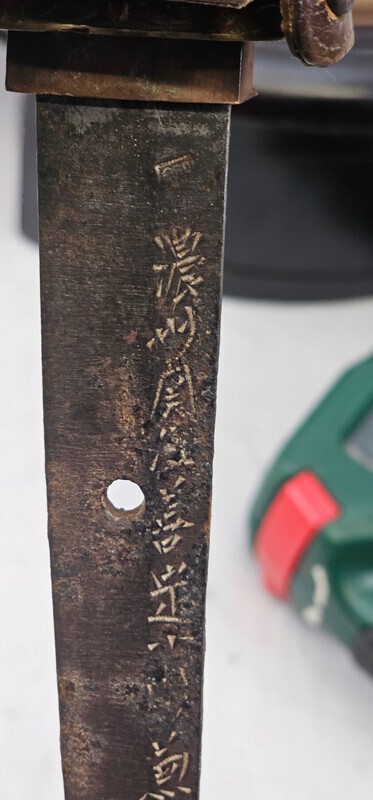
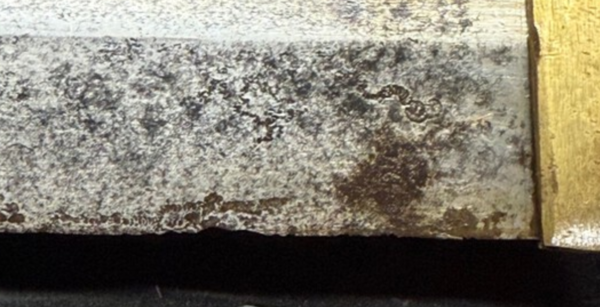











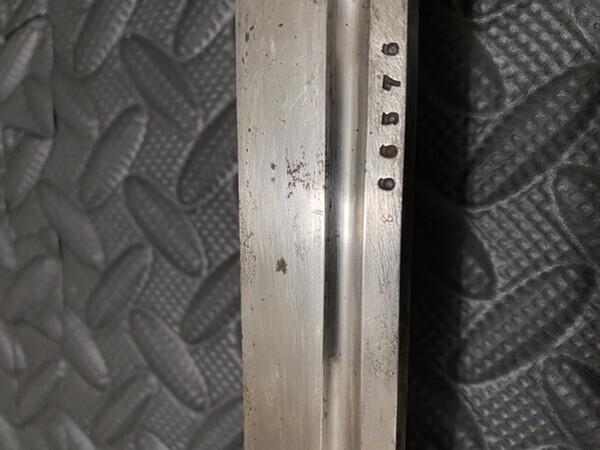

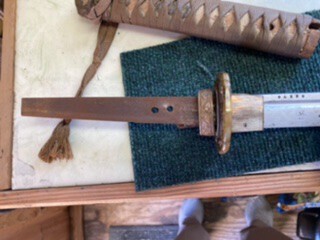

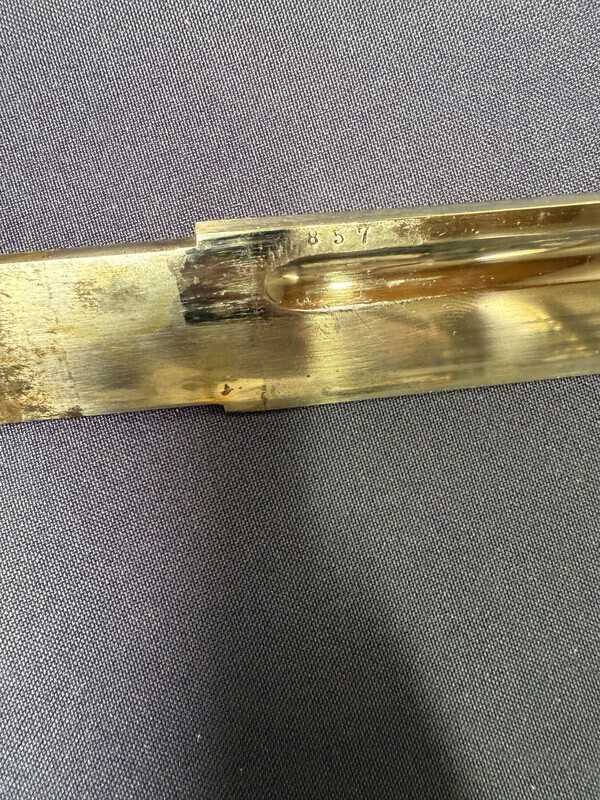
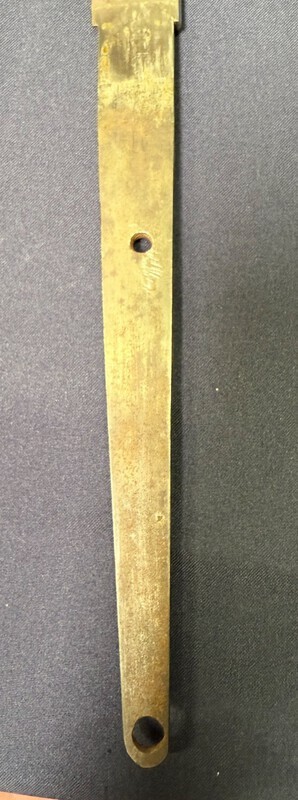
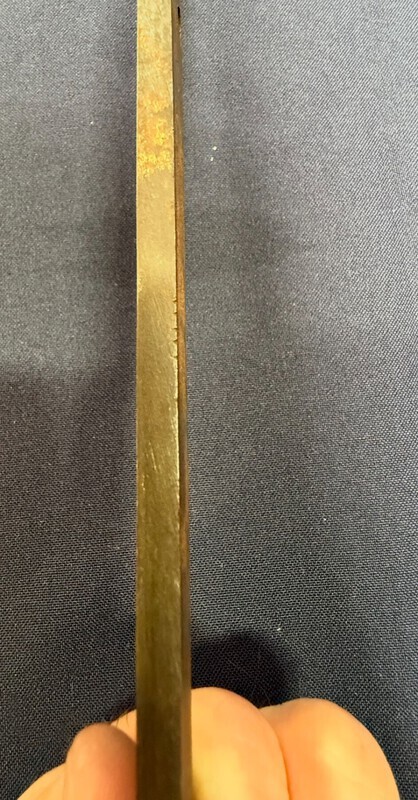

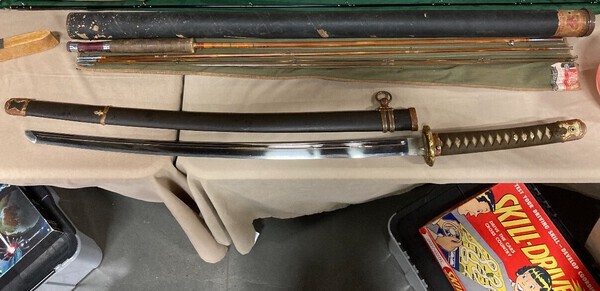
-Copy.thumb.jpeg.c0ea8fc0dc9ff5c5e0e1b569a32a36c7.jpeg)
-Copy-Copy.thumb.jpeg.db71ee7e9004889253f30af72c685ac8.jpeg)
.thumb.jpeg.8b6ab8b15bd8196f4cb4c14117efdddd.jpeg)
.thumb.jpeg.7519f6123b94206eff0c9fd0284f2e26.jpeg)
-Copy.thumb.jpeg.02355387231392fa13ae33201a11b33f.jpeg)